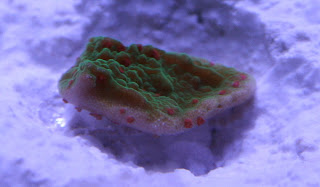1) remove old Hawaiian feather duster leftover tube.
The thing lost its crown two weeks ago while I was scraping off algae from the acrylic walls. I must have given it a fright. Later on, something gave it a big hicky and then it became a number one food item for Nassarius snails and hermit crabs. The poor polycheate had slithered out of its tube taking its last gasps of...of....oxygenated water when I fished it out. There was something oddly familiar about it; I must have done this a hundred times when I was a toddler on the shores of Okinawa, Japan.
2) Glue down frags.
a) orange Pavona sp.
b) blue-tipped Acropora sp.
c) Red Hot Chili Pepper Monti
d) Bird's Nest
I should glue them down ASAP before hermit crabs, bulky snails or a Tuxedo sea urchin tip them over onto another coral where it will suffer from stings. But, I don't. I dunno why.
3) Remove "Surf-n-Turf" Acro frag and play mad scientist on red bugs.
I took this thing out and did a freshwater dip in diluted sea water. I probably killed it in the process. It was just satisfying killing off the bugs before I killed my coral. I will believe in Neptune if this frag rises from the dead.
4) Find a place for the Kenya Tree frag.
The pistol shrimp purloined the frag to the murky catacombs he engineers underneath the live rock. Maybe it created a stink because it was offered up at another cave entrance several weeks later. Then, it disappeared again. The second appearance called for a prompt, evasive action on my part.
5) Do something about that other Acro that looks like it's suffering from AEFW attack.
Upon further inspection with a magnifying glass, I see no predators and it looks more like random bleaching rather than bite mark patterns which generally are supposed to start from the bottom up. I'll just give more time to acclimate to my tank.
6) Move Orange Turbo snail from refugium to main tank.
He's been eating up too much stationary macro algae. Put him to work in the main tank where he'll be harassed by the fish.
7) Get snails out of the exit area of the refugium.
Periodically, the snails migrate over the dam and go down into the exit area of the refugium which drains into the sump. I have to use a scraper to reach them because my hand doesn't fit there. It's a joy ride for them, I guess.
8) Replace the loc-line on the returns that I removed a few weeks ago.
I'm still thinking about this. I don't think it's necessary to have them there and I like the way it looks. Although, when I turn off the return pump during feeding time, I have seen the Midas Blenny go and stick his body in the return for a bit. I can't imagine what would happen if he decided to go ALL THE WAY DOWN the return and then being forced out when the return pump turns back on.
9) Water Chemistry.
It's that time. Time to measure calcium, alkalinity, pH, salinity and magnesium. Perhaps I'll take a look at nitrates as well?
10) Get 5 gallons of Scripps sea water ready for the water change.
Then, I finished this blog entry. So, the work continues tomorrow!



















 Upgrade Kit and old pump
Upgrade Kit and old pump

 Pulsing Xenia As Found At The Pet Store
Pulsing Xenia As Found At The Pet Store Two Pulsing Xenia Colonies "On The Verge"
Two Pulsing Xenia Colonies "On The Verge" Pulsing Xenia Responding to New Conditions
Pulsing Xenia Responding to New Conditions












